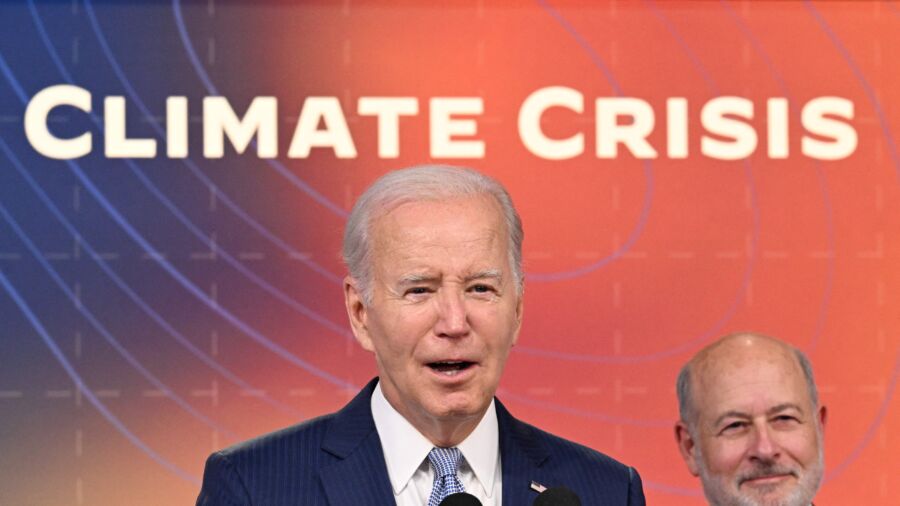President Joe Biden issued the first ever heat hazard alert for U.S. workers on July 27. The president unveiled new strategies to protect Americans from what the White House termed “extreme heat.”
“Today, President Biden will convene Mayor Kate Gallego of Phoenix, Arizona, and Mayor Ron Nirenberg of San Antonio, Texas, to hear from them directly about how their communities are being impacted by extreme heat and to discuss the steps the Biden-Harris Administration is taking to protect communities like theirs,” according to the press release.
The move comes as many regions of the country have continued to face the effects of a heat wave, leading the president to instruct the Department of Labor (DOL) to issue a hazard alert.
“For years, heat has been the number one cause of weather-related deaths in America—with more than 600 heat-related deaths every year. And workers, including farmworkers, farmers, firefighters, and construction workers, are disproportionately impacted,” the press release goes on to say.
Contradictory Claims on Heat Deaths
The White House briefing, however, contradicts data on temperature-related mortality published in The Lancet in 2021. In the Lancet study, the number of excess deaths in North America due to “non-optimal temperatures” from 2000 to 2019 was estimated to be 191,414. Of this number, over 171,000 deaths were described as cold-related deaths, while just over 20,000 were said to be heat-related.
The data from North America corresponds approximately to global figures quoted by researcher and president of the Copenhagen Consensus Center, Bjorn Lomborg.
“Cold deaths vastly outweigh heat deaths,” Mr. Lomborg wrote in an article quoting The Lancet’s 2021 paper. “This is common knowledge in the academic literature and, for instance, the Lancet finds that each year, almost 600,000 people die globally from heat, but 4.5 million from cold.
“Moreover, when the researchers include increasing temperatures of 0.26°C/decade (0.47°F/decade), they find heat deaths increase, but cold deaths decrease more than twice as much.”
However, Mr. Lomborg stated on social media in 2021 that he believes this information “doesn’t fit [the] climate alarm narrative.”
His sentiments were echoed by the founder of Environmental Progress, Michael Schellenberger.
“If we had to choose, we’d rather the world got warmer than cooler, since more people die of cold than heat, and because warmer temperatures make more rather than less land available for farming, but too much heat creates new risks,” Mr. Schellenberger posted on social media in 2021.
DOL Measures to Combat ‘Extreme Heat’
According to the White House, the DOL will now issue directives to employers on how to protect their employees from the heat. The directives will also include enforcement of inspections that facilitate additional safety measures in industries most at risk, such as construction and agriculture, and ensure workers are made aware of their rights.
Meanwhile, the Occupational Safety and Health Administration (OSHA) will continue to develop a national standard for workplace heat-safety rules.
In addition, up to $7 million from President Biden’s Inflation Reduction Act will be allocated to improve the nation’s weather forecasts via the National Oceanic and Atmospheric Administration (NOAA). “These improved forecasts will allow communities to better prepare for extreme weather events, including long periods of extreme heat,” according to the White House.
A further $152 million will be provided to expand water storage and enhance climate resilience in California, Colorado, and Washington, from President Biden’s Bipartisan Infrastructure Law.
“This investment will help increase water storage capacity and lay conveyance pipeline to deliver reliable and safe drinking water and build resiliency for communities most impacted by drought,” according to the release.
The White House press release states that billions of dollars have been granted through the Department of Housing and Urban Development to finance more energy-efficient buildings and to open “cooling centers to keep residents safe.”
Alongside wildfires in Canada, parts of the United States have experienced continued exposure to heat exceeding 110 degrees this year, as well as lowered air quality values in multiple states as a result of the fires.
San Antonio, Texas recently experienced more than 14 consecutive days where the mercury exceeded 100° F. At least 13 people are reported to have died in Texas as a result of the heat this year.
The Associated Press contributed to this article.

